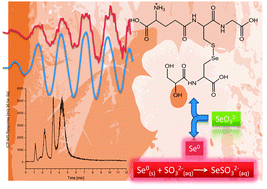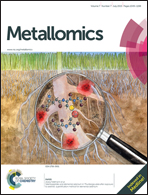Selenopeptides and elemental selenium in Thunbergia alata after exposure to selenite: quantification method for elemental selenium†
Abstract
Three month old Thunbergia alata were exposed for 13 days to 10 μM selenite to determine the biotransformation of selenite in their roots. Selenium in formic acid extracts (80 ± 3%) was present as selenopeptides with Se–S bonds and selenium–PC complexes (selenocysteinyl-2-3-dihydroxypropionyl-glutathione, seleno-phytochelatin2, seleno-di-glutathione). An analytical method using HPLC-ICPMS to detect and quantify elemental selenium in roots of T. alata plants using sodium sulfite to quantitatively transform elemental selenium to selenosulfate was also developed. Elemental selenium was determined as 18 ± 4% of the total selenium in the roots which was equivalent to the selenium not extracted using formic acid extraction. The results are in an agreement with the XAS measurements of the exposed roots which showed no occurrence of selenite or selenate but a mixture of selenocysteine and elemental selenium.


 Please wait while we load your content...
Please wait while we load your content...